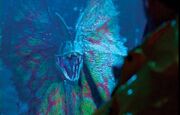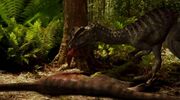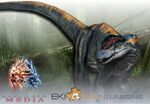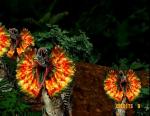| Dilophosaurus Temporal range: Early Jurassic | |
|---|---|

| |
| Dilophosaurus by Kaneki Ken Engh | |

| |
| Skeletal of Dilophosaurus by TheSynopsis | |
| Scientific classification | |
| Kingdom: | Animalia |
| Phylum: | Chordata |
| clade: | Dinosauria |
| Order: | Saurischia |
| Suborder: | Theropoda |
| Family: | †Dilophosauridae |
| Genus: | †Dilophosaurus Welles, 1970 |
| Species: | †D. wetherilli |
| Binomial name | |
| †Dilophosaurus wetherilli Welles, 1954 | |
| Synonyms | |
| |
Dilophosaurus (Greek, "double crested lizard") is a dilophosaurid theropod dinosaur from the early Jurassic. The genus was the first large carnivorous dinosaur to appear in North America, showing up in the Early Jurassic. It is distinctly known from its famous two crests rounding above its skull, from which the animal gets its namesake. Its fossils were uncovered in Southwestern US and possibly China. Although primitive compared to genus Tyrannosaurus or Allosaurus, it was actually a very advanced predator for its time.
History of discovery[]
In the summer of 1942, the American paleontologist Charles L. Camp led a field party from the University of California Museum of Paleontology (UCMP) in search of fossil vertebrates in Navajo County in northern Arizona. Word of this was spread among the Native Americans there, and the Navajo Jesse Williams brought three members of the expedition to some fossil bones he had discovered in 1940. The area was part of the Kayenta Formation, about 32 kilometers (20 mi) north of Cameron near Tuba City in the Navajo Indian Reservation. Three dinosaur skeletons were found in purplish shale, arranged in a triangle, about 9.1 meters (30 ft) long at one side.
The first was nearly complete, lacking only the front of the skull, parts of the pelvis, and some vertebrae. The second was very eroded, included the front of the skull, lower jaws, some vertebrae, limb bones, and an articulated hand. The third was so eroded that it consisted only of vertebra fragments. The first good skeleton was encased in a block of plaster after ten days of work and loaded onto a truck, the second skeleton was easily collected as it was almost entirely weathered out of the ground, but the third skeleton was almost gone.
Description[]
Dilophosaurus measured around 6 meters (20 feet) long and may have weighed half a ton. Fossils of the animal have been found at the Navajo Indian Reservation, just west of Tuba City, Arizona, USA and in the Kayenta Formation. Just a few tens of feet below the level of the bones, large footprints of carnivorous dinosaurs were found and these may belong to Dilophosaurus. It lived in the Early Jurassic Period, from the Sinemurian to the Pliensbachian stages (193-183 million years ago), and was more primitive than later carnivores of the Jurassic, such as Ceratosaurus or Allosaurus.
The original description was published in 1954, by the renowned paleontologist Samuel Welles. However, at the time, it was thought to be another genus of theropod (Megalosaurus). In 1970, it was recognized to be distinct and given its own generic name Dilophosaurus. Welles later redescribed the entire taxon in 1984, in a more comprehensive paper. Dilophosaurus may be a primitive member of the clade containing both ceratosaurian and tetanuran theropods. Alternatively, some paleontologists classify this genus as a large coelophysoid. Recent Dilophosaurus 'skin imprints', associated with a set of footprints, seemed to suggest that it had feathers but further study revealed these to be impressions of plant material.
Footprints of a Dilophosaurus-like predator have been discovered in the Lavini di Marco area, near Rovereto (Trentino, northern Italy).
Meanwhile the Dilophosaurus' true diet is unknown; it is assumed that the animal had probably a mixed diet of both terrestrial and aquatic prey; similiar to spinosaurids, as its speculated to be large enough to hunt large prosauropods as well as smaller dinosaurs including the local species of Coelophysis (C. kayentakae) and Sarahsaurus. Latter research also concluded the possibility of fish-hunting on rivers and delta's. [1]
The Latest Research has reinstated the the dinosaur to being a potential macropredator. [2]
Classification[]
In 1954 Welles thought that Dilophosaurus was a megalosaur, but later in 1970 revised his opinion because he discovered Dilophosaurus had crests. By 1974 Welles and paleontologist Robert A. Long found Dilophosaurus to be a ceratosauroid, and in 1984 he found that Dilophosaurus exhibited features of both Coelurosauria and Carnosauria, the two main groups into which theropods had hitherto been divided, based only on body size, and he suggested this division was inaccurate. Welles found Dilophosaurus to be closest to the theropods that were placed in Halticosauridae, especially Liliensternus.
In 1988 Gregory Paul classified halticosaurs as a subfamily of the family Coelophysidae, and proposed that Dilophosaurus could have been a direct descendant of Coelophysis. He also considered the possibility that spinosaurs were late-surviving dilophosaurs, based off the similar nostril position, kinked snouts, and slender teeth of Baryonyx. In the year 1994, paleontologist Thomas R. Holtz placed Dilophosaurus in the Superfamily Coelophysoidea, along with but separate from the Coelophysidae. Thomas Holtz placed Coelophysoidea in Ceratosauria, and in 2000, paleontologist James H. Madsen and Welles divided Ceratosauria into the families Ceratosauridae and Dilophosauridae.
In 1998 Lamanna and colleagues pointed out that since Dilophosaurus was discovered to have had crests on its skull, other similarly crested theropods have been discovered (including Sinosaurus), and that this feature is, thus, not unique to the genus, and of limited use for determining interrelationships within the group. Paleontologist Adam M. Yates described the genus Dracovenator from South Africa in 2005, finding it closely related to Dilophosaurus and Zupaysaurus. His cladistic analysis suggested they did not belong in the Coelophysoidea, but instead in Neotheropoda, a more derived (or '"advanced"') group.
He suggested that if Dilophosaurus was more derived than the Coelophysoidea, the features it had with this grouping may have been inherited from basal (or '"primitive"') theropods, indicating that theropods may have passed through a "coelophysoid stage" in their early evolution.
In the year 2007, Nathan D. Smith and colleagues found the crested theropod Cryolophosaurus to be a sister species of Dilophosaurus, and grouped them with Dracovenator and Sinosaurus. This clade was more derived than the Coelophysoidea, but more basal than the Ceratosauria, as a result of that placing basal theropods in a ladder-like arrangement. In 2012, paleontologist Carrano and colleagues found that the group of crested theropods proposed by Smith and colleagues was based on features that relate to the presence of such crests, but that the features of the rest of the skeleton were less consistent. They instead found that Dilophosaurus was a coelophysoid, with Cryolophosaurus and Sinosaurus being more derived, as basal members of the group Tetanurae.
The paleontologist Christophe Hendrickx, and colleagues defined the Dilophosauridae to include Dilophosaurus and Dracovenator in 2015, noting that while general uncertainty exists about the placement of this group, it appears to be slightly more derived than the Coelophysoidea, and the sister group to the Averostra. Dilophosauridae share features with the Coelophysoidea such as the subnarial gap and the front teeth of the maxilla pointing forwards, whilst features shared with Averostra include a fenestra at the front of the maxilla and a reduced number of teeth in the maxilla, they suggested that the cranial crests of Cryolophosaurus and Sinosaurus had either evolved convergently, or were a feature inherited from a common ancestor.
In 2019, Marion Zahner and Winand Brinkmann found the members of the Dilophosauridae to be a successive basal sister taxa of the Averostra rather than a monophyletic clade (a natural group), but noted that some of their analyses did find the group valid, containing Dilophosaurus, Dracovenator, Cryolophosaurus, and possibly Notatesseraeraptor as the basal-most member. They then provided a diagnosis for Dilophosauridae, based on features in the lower jaw. In the phylogenetic analysis accompanying their 2020 redescription, Rower and Marsh found all specimens of Dilophosaurus to form a monophyletic group, sister to Averostra, and to be more derived than Cryolophosaurus. Their analysis did not find support for Dilophosauridae, and then suggested cranial crests were a plesiomorphic (ancestral) trait of Ceratosauria and Tetanurae.
Ichnology[]
Multiple ichnotaxa (taxa based on trace fossils) have been assigned to Dilophosaurus or other similar theropods. Welles in 1971, reported dinosaur footprints from the Kayenta Formation of northern Arizona on two levels 14 m (45 ft) and 112 m (367 ft) below where the original Dilophosaurus specimens were found.
Skull and Crests[]
The most distinctive characteristic of Dilophosaurus was the pair of rounded crests on its skull, probably used for display. Studies by Rob Gay (2001) show that these crests may have been larger in one sex than in the other. Another curious skull feature was a notch behind the first row of teeth, giving it an almost crocodile-like appearance. This "notch" existed by virtue of a weak connection between the premaxillary and maxillary bones of the skull. This conformation led to the early hypothesis that Dilophosaurus scavenged off dead carcasses, with the front teeth being too weak to bring down and hold large prey. A similar notch is present in most other species of coelophysoid.
Species[]
There is another species of Dilophosaurus (D. sinensis), which may or may not belong to this genus. It is possibly closer to the bizarre Antarctic theropod Cryolophosaurus, based on the fact that the anterior end of the jugal does not participate in the internal antorbital fenestra and that the maxillary tooth row is completely in front of the orbit and ends anterior to the vertical strut of the lacrimal. This species was recovered from the Yunnan Province of China in 1987, with the prosauropod Yunnanosaurus and later described and named in 1993 by Shaojin Hu.
In popular culture[]

Jurassic Park variant of Dilophosaurus, where it is shown having a juicy frill, result of Genetical modifications
- Dilophosaurus was featured in the 1993 Film Jurassic Park and in the original novel by Michael Crichton (on which the film was based). In the film version, it had a retractable frill around its neck, much like a Frilled Lizard, and was able to shoot venom, like a spitting cobra, aiming for the eyes to blind and paralyze its prey. There is no true fossil evidence to support this representation, which was invented by the author and director to heighten suspense. However, this is explained by saying that this was due to genetic tampering with spitting cobra and Austrailian frilled lizard DNA. In the film the director Steven Spielberg reduced its size, from moderately large to about 3 feet tall and 5 feet long - this was so as not to overshadow the main star of the movie, Tyrannosaurus rex. In the novel, the creature was 10 feet tall with no frill and had poisonous saliva that was used in predation by biting or spitting at its prey. In the novel, this trait was discovered by the researchers at Jurassic Park, who planned to remove the glands containing the poison. This plan was not carried out - an autopsy would have been needed to see how to remove the glands, but it would have required killing a Dilophosaurus, which John Hammond, owner of the park, opposed.
- No Dilophosaurus were known to have been held publicly in Jurassic World, nor were listed on its official website as attractions, but the Innovation Center included it in the Holoscape, along with Velociraptor, Spinosaurus & other dinosaurs created by InGen but not kept on display in the park. The glass of the Gyrosphere is designed to protect visitors even from them, meaning that it could have been in the park at one point. During the second Isla Nublar incident, the holographic display of Dilophosaurus was briefly used by Gray Mitchell to distract Delta the Velociraptor while he, Claire Dearing, Owen Grady, and his brother Zach Mitchell escaped the building.

When Dinosaurs Roamed America Dilophosaurus
- Dilophosaurus appeared in Dinosaur Hunting Xbox where only one in stage 1 resembles the Jurassic Park counterpart but with a feathered frill instead and spits poison.
- While not on screen for Jurassic World: Fallen Kingdom, it has been revealed that there are surviving Dilophosaurus populations on Isla Nublar, but they and many other creatures will now face an impending danger in the form of an erupting volcanic eruption from Mount Sibo. However, during the operation to retrieve a bone from the skeleton of the Indominus rex, a man named Jack was briefly startled by the sound of a Dilophosaurus hooting in the jungle near the mercenaries' Main Street campsite. However he resumed his work without encountering the dinosaur, likely because the approaching T. rex scared the smaller predator away. But it is possible that some Dilophosaurus was saved offscreen. In the museum in Lockwood Manor, a statue Dilophosaurus can be seen fighting a statue brown Velociraptor. The Dilophosaurus in the estate is mainly green with red crests and frill. Dilophosaurus was meant to appear proper in Jurassic World: Fallen Kingdom, but it was cut from the final film.

The dinosaur in a Jurassic Park video arcade game

Primal Carnage Dilophosaurus
- Jurassic Park merchandise, including toys and video games (such as Jurassic Park: Operation Genesis, Jurassic World: Evolution, Lego Jurassic World and the arcade games The Lost World: Jurassic Park and Jurassic Park III), often include Dilophosaurus.
- Dilophosaurus appeared in other video games such as ParaWorld, Jurassic The Hunted, and Ice Age Dawn of the Dinosaurs feature Dilophosaurus modelled after the one in Jurassic Park. It can be also created from DNA in Jurassic Park: Builder as well. It also makes an appearance in Turok, where it is more accurately sized than the one in Jurassic Park.
- A Dilophosaurus was seen briefly along with different species of Dinosaurs from the Jurassic Period in the 3rd episode of the PBS Program The Dinosaurs! “The Nature of the Beast”.
- A Dilophosaurus appeared in an Animated Dinosaur Documentary & its color appearance matches that of the Dilophosaurus created by Dinamation. “Only a few stock footages “Archive Footage” of the Animated Documentary it came from was seen in Really Wild Animals: Dinosaurs & other Creature Features. The real Documentary is a mystery. Probably from Dinosaurs on Earth: Then...and Now by the National Geographic Society.”
- Dilophosaurus is shown in Dinosaur King.
- An Illustration of a Dilophosaurus was seen at the beginning of the 1998 version of The Lost World along with the name “Jack Langedijk”.
- Dilophosaurus was also featured in the documentary When Dinosaurs Roamed America, killing an Anchisaurus and scaring off a pack of Syntarsus.
- Dilophosaurus also appeared in the first episode of the documentary Prehistoric: New York where it was seen catching a fish.
- A pair of Dilophosaurus appeared in the Nat. Geo. documentary Earth The Making of a Planet AKA The History Of Earth or The Story Of Earth Where they were hunting a Pro-Sauropod Ammosaurus.
- A pair of Twin Dilos named Devlon & Dylan made an appearance in Dinosaur Train.
- It appears in Jurassic World: The Game as a rare carnivore. Its frills are relatively large.
- It also appears in the 2019 Disney show Gigantosaurus as a character named Dilo who’s a friend of the 4 Dino kids Mazu, Rocky, Tiny & Bill.
- It also appears in Dinosaur World Mobile.
- Dilophosaurus was added to Prehistoric Kingdom in Update 1.1.
Videos[]

Dilophosaurus Triple Threat (WDRA)
Other Wikis[]
References[]
- https://www.nationalgeographic.com/science/article/jurassic-park-got-almost-everything-wrong-about-iconic-dinosaur-dilophosaurus
- https://www.nhm.ac.uk/discover/dino-directory/dilophosaurus.html
- https://scienceviews.com/dinosaurs/dilophosaurus.html
- https://dinomuseum.ca/2019/04/23/the-real-dilophosaurus/
- https://indianexpress.com/article/explained/jurassic-parks-dilophosaurus-what-did-it-really-look-like-6502714/
- https://www.heritagedaily.com/2020/07/dilophosaurus-is-less-lizard-more-bird/134128
- https://palaeo-electronica.org/content/2011-11-30-22-01-23/2634-the-forelimbs-of-dilophosaurus-what-can-they-tell-us-about-an-iconic-dinosaur
- https://kids.nationalgeographic.com/animals/prehistoric/facts/dilophosaurus
- http://files.geology.utah.gov/surveynotes/articles/pdf/fishing_dinos_39-3.pdf
- https://www.scientificamerican.com/article/the-real-dilophosaurus-would-have-eaten-the-jurassic-park-version-for-breakfast/
- https://www.cambridge.org/core/journals/journal-of-paleontology/article/comprehensive-anatomical-and-phylogenetic-evaluation-of-dilophosaurus-wetherilli-dinosauria-theropoda-with-descriptions-of-new-specimens-from-the-kayenta-formation-of-northern-arizona/39C2921EDC6E951AC9F94A22158CA4E5
- https://www.ncbi.nlm.nih.gov/pmc/articles/PMC6179219/
- https://www.ncbi.nlm.nih.gov/pmc/articles/PMC4684415/
- https://www.cambridge.org/core/journals/journal-of-paleontology/article/comprehensive-anatomical-and-phylogenetic-evaluation-of-dilophosaurus-wetherilli-dinosauria-theropoda-with-descriptions-of-new-specimens-from-the-kayenta-formation-of-northern-arizona/39C2921EDC6E951AC9F94A22158CA4E5
- https://news.utexas.edu/2020/07/07/famous-jurassic-park-dinosaur-is-less-lizard-more-bird/
Gallery


